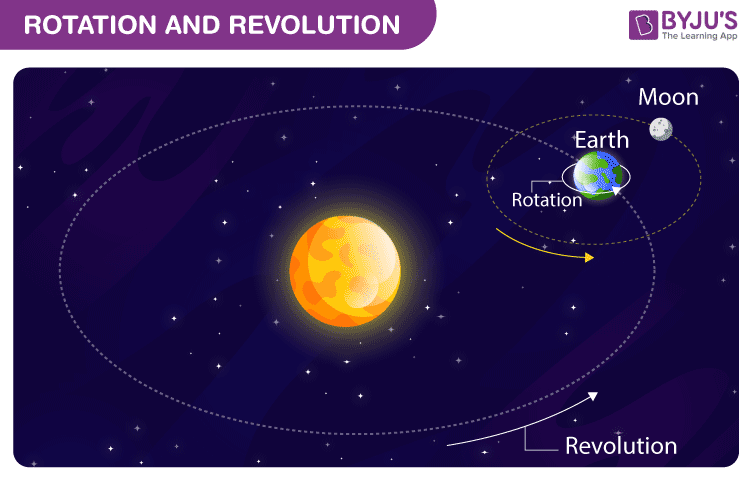What is Rotation?
A rotation is a circular movement of an object around a centre of rotation. If three-dimensional objects like earth, moon and other planets always rotate around an imaginary line, it is called a rotation axis. If the axis passes through the body’s centre of mass, the body is said to rotate upon itself or spin.
What is Revolution?
Revolution is often used as a synonym for rotation. However, in many fields like astronomy and its related subjects, revolution is referred to as an orbital revolution. It is used when one body moves around another, while rotation is used to mean the movement around the axis. For example, the Moon revolves around the Earth and the Earth revolves around the Sun.

Rotation of the Earth
The spinning of the Earth around its axis is called ‘rotation’. The axis has an angle of
Benefits of Earth Rotation
Some of the benefits of the rotation of Earth are listed below:
- The earth rotation creates the diurnal cycle of lightness and darkness, temperature and humidity changes.
- The earth rotation causes the tides in the oceans and seas.
Revolution of the Earth
The movement of the Earth around the Sun in a fixed path is called a revolution. The Earth revolves from west to east i.e, in the anticlockwise direction. The Earth completes one revolution around the Sun in one year or precisely in 365.242 days. The revolution speed of the earth is 30 km/s-1.
Rotation and Revolution of Planets
| Planets | Mean distance from the Sun in millions of kilometres | Period of Revolution | Period of Rotation |
| Mercury | 57.9 | 88 days | 59 days |
| Venus | 108.2 | 224.7 days | 243 days |
| Earth | 149.6 | 365.2 days | 23 hr, 56 min, 4 sec |
| Mars | 227.9 | 687 days | 24 hr, 37 min |
| Jupiter | 778.3 | 11.86 years | 9 hr, 55 min, 30 sec |
| Saturn | 1,427 | 29.46 years | 10 hr, 40 min, 24 sec |
| Uranus | 2,870 | 84 years | 16.8 hours |
| Neptune | 4,497 | 165 years | 16 hr, 11 min |
Difference Between Rotation and Revolution
The table given below provides the basic differences between rotation and revolution.
| Rotation | Revolution |
| Rotation of the Earth is its turning on its axis. | Revolution is the movement of the Earth around the Sun. |
| The Earth takes 24 hours to complete a rotation with respect to the sun. | The Earth takes a full year (365 days) for one complete revolution around the Sun |
| The Earth’s axis of rotation is tilted by 23.5 degrees. This tilt causes the different seasons of the year. | The path of the Earth moving around the Sun is called an orbit. The Earth’s orbit is elliptical. |
Watch the video below to understand what would happen if the Earth stopped spinning.

Frequently Asked Questions on Rotation and Revolution of Planets
Do earthquakes affect the Earth’s rotation?
Using the data from the Indonesian Earthquake, NASA calculated that earthquake affected Earth’s rotation, decreased the length of the day, shifted the North Pole by centimetres and slightly changed the planet’s shape. The earthquake that creates huge tsunami also changed the Earth’s rotation.
Has the Earth’s rotation ever speeded up in the past?
Probably, but in the last 900 million years, any speed-ups have been superimposed on a more or less steady slow down in spin rate. Even today, we can identify how the rotation rate of the Earth changes fast and slow by milliseconds per day, depending on how the mass distribution of the Earth and its atmosphere change from earthquakes and the movement of water and air.
Is it possible to slow down the Earth’s rotation artificially?
It is said that humans have made a measurable change in the Earth’s rotation period of the Earth by several microseconds by accumulating vast reservoirs with trillions of tons of water. There may be a weak interaction between this activity and the weather over the long term, and possibly even in the strength of the Earth’s magnetic field which is very sensitive to the rotation rate of the Earth.
What is the angle made by the axis of the earth with its orbital plane?
The angle made by the axis of the earth which is an imaginary line with the orbital plane is 66 degrees.
What is an equinox?
An equinox is defined as the time when the sun crosses the celestial equator such that the length of the day and night are equal. Every year has two equinoxes. Also, the length of nights at latitudes L degree north and L degree south are equal.




So What Happens When We Have Long Day And Short Night And Vice Vesa
You can read about it here.
It help me a lot thanku very much byjus